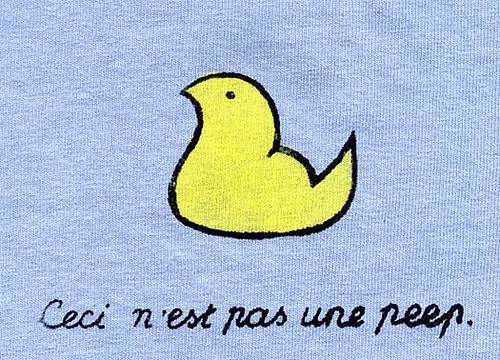After our class discussion last Monday in regards to modernism, structuralism, and post-modernism, I began to think about what some of the theorists thought about the nature of reality. Nearing the end of class, I said, in order to clarify my own thoughts and un-muddy my mental waters (not near as eloquently or in as much detail, but I paraphrase and elaborate here to make myself look like I know what I'm talking about):
"So structuralists, like Saussure for example, believe that signifiers and signifieds are generally fixed for a period of time. They can change, but usually after at least a brief period of stability. For example, I can define what a cat is and what it isn't by comparing it to an infinite about of objects, and over time the way I define cat can change as my understanding of its relationships with everything else changes. But if I'm looking at it from a post-Modernist or post-structuralist standpoint like Derrida, then there is no stability in regards to the fixed nature of definitions since the relationships themselves are arbitrary -- they can literally change from country to country, day to day, person to person, instant to instant. If what I define a cat as changes, then so does its relationship to dog, and then the definition of dog changes which also alters the definitions of everything else dog is related to. Therefore, there is a constant flux between what is and what isn't, pretty much meaning that, well, there is no meaning to anything."
(I'm a fantastic bore in class)
I felt a little bit as I did when reading Plato's Republic for my Critical Theories class. Plato separates, well pretty much everything, into "the world of ideas" and "the world of appearances". To Plato, the only reality, the only thing of real true value is the idea -- the concept of furniture, the thought of a statue, the concept of a finely cooked meal. Anything else -- the physical poker table, the tangible statue of David, the corporeal 8 ounce New York strip steak, medium-rare with garlic mashed potatoes and broccoli and cauliflower lightly drizzled with butter and Parmesan cheese -- is just a representation of the idea and is thus inferior. I thought "Then anything and everything around me, including my physical body (shock! horror! surprise?) is simply inferior and flawed beyond appreciation. Even that steak I just drooled over?? Thanks, stupid Plato..."
However, I personally decide not to take such a view as Plato or Derrida. There's no fun in it, it seems rather pessimistic to me. And while I can often be a bit of a harsh cynic, I do always strive to find meaning in all that is around me, most often through humor. This clouding of the nature of reality that Plato and Derrida arouse makes me think of René Magritte, the surrealist painter. In particular, it reminds me of one of his most famous paintings, The Treachery of Images:
This, Magritte says, is not a pipe -- it is merely a representation of a pipe ("Just try to stuff it with tobacco!" he said). And, according to Plato, the arts are twice removed from reality, making them even more inferior. So this "pipe" is, at minimum, three-times removed from our reality. Ironically, this is one of Magritte's most famous paintings. What a hack.
Of course, this image has been co-opted by the generations that followed it, producing and re-producing and so on. Treachery has even found its way onto t-shirts, including some that poke fun at it:
It makes me wonder what post-structuralists would say when I asked them why it took so long for the meaning and definition of Magritte's message to be interpreted on a shirt that that would likely be found at Hot Topic. What do you say to that, Derrida?
Now, to enjoy my flawed steak. Stupid Plato...


No comments:
Post a Comment